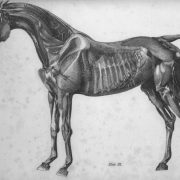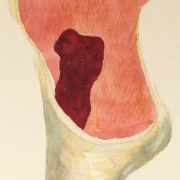[FS/2/2/2/1/2]
[[1]]
[Annotated ‘Ostitis[sic]’]
D 47 12RL On opening the muscles there was nothing to be seen but that the muscles were paler than usual & on opening the capsule of the joint the synovia was in excess & deeply died[sic] with blood, the synovial membrane was thicker than usual but not inflamed. The articular cartilage rather swollen and soft around the circumference of the humerus, but in no wise[?] inflamed or ulcerated, towards the ant: internal part of the articular surface of the scapular there was a slight abrasion, notched like of its circumference, it was smaller than a pea, but the cartilage was swollen & the bone was distinctly felt bare[?] in its centre, it was not inflamed or was there any sign of ulceration. The flexor Brachii[?] at its origin seemed injected & there was a bruise the size of a bean just below its tendon on the outside. The sub scapularis muscle had suffered, it presented the appearance of being severely bruised, ecchymosed through half its length and entire thickness. I could detect no rupture of its fibres, & its insertion was intact. The humerus & Scapular through half their length were congested, the periostium thickened and easily removed leaving the injected bone beneath. More particularly was this the case in certain parts such as near the insertion of the sub scapularis but the outside of the joint had shared in this apparently inflamed process but not to the same extent. There was osteitis of Humerus – see sketch
The history of the case of which the above is the post mortem is that on March 1st this horse collided during competition with a much heavier one, was struck on the near shoulder & knocked over. She fell on her side, but got up & walked to the infirmary with the leg dangling about like a broken one, thrown across the front of its fellow, the elbow being turned out, was placed in slings. When again examined next day when made to move the whole shoulder seemed to come out laterally the elbow turned out & the giving was so great that the animal leant entirely over to that side. I believe the 4th Condyle of humerus is knocked off & with it the attch of Portea Spinatus
March 6 – Blistered and consulted with Brown[?] & he thinks a fracture.
I divided this muscle in a dead limb and produced the deformity.
March 20 – No better. Shoulder still out or seems to be every time he[sic] moves he can stand fair on limb, but can put no weight, can even make with, has a great knack of crossing his legs both front and rear Placed in slings and tied in. Pitch plaster &c. Placed the off fore on top of rear foot. Kicks the ground constantly. I think[?] from blister – but he does it day and night. Cause on P.M.E The lumbricoides
April 7 – Found with tetanus. Owing I think from chafes in slings.
[Annotated ‘Urine SpGz 1050. Ammonial & phosphates]
[[2]]
[Annotated ‘Lameness’]
Veterinary Regulations
Death Report
Regiment: 12 R Lancers
Station: Bangalore
Date: 8ber 1883
Troop or Battery: D
Number of Horses: 47
Sex: M
Age: 4
Disease: Tetanus
Date of Admission: April 7th 83
Date of Death: April 8th 83
Record of the Case
Copied from the Record Case Book
Case 62 D47
1883
7th April
Tetanus
This horse has been in the sick lines since March 1st with what I considered to be a fracture of the point of shoulders (near) there being extreme lameness & apparently dislocation. He was placed in slings. Lately he was found to be rather chafed round the chest as he was very uneasy and always kicking. This latter was not vice but was too continuous for such a long period not to attract attention
[[3]]
On visiting him this morning he was slightly blowing but feeding. On seeing him ¾ of an hour
later my suspicions were confirmed & I immediately administered, or rather tried to, a purgative. He lost nearly the whole dose. I then gave Carum[?] Indic: Ʒij with Heum Crosonis mxx in a ball. I managed to get this down. Removed to a loose box, & kept perfectly quite[sic], pulse normal, Temp 100o.
6.30pm Worse, the disease at its full height
At 9 am dropped down & died asphyxiated. [Annotated ‘8th’]
Autopsy. All viscera normal, but the stomach & duodenum contained I should say 500 Ascarides many of them over a foot in length, they nearly filled the duodenum
Remarks. Was it the chafe or Ascarides caused the tetanus. My view of the matter is that the chafe produced the mischief. The presence of this enormous number of parasites undoubtedly produced the great nuisance[?] which shewed itself in the continuous kicking there was no fracture of the shoulder, but ordeals[?] of humerus & severe bruising of Sub scapularis muscle
Discharged died
F Smith
[[4]]
Osteitis of Humerus D 47
[Painting]
A section of the head of the humerus of D47. The medulla was exactly the above colour & the cancellous tissue was just as represented. I made no section of the scapular[sic] but I am sure it was the same.
[Transcription by Claudia Watts, KCL History, April 2019]



